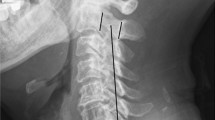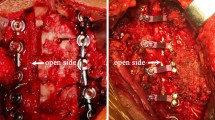Abstract
Purpose
To evaluate the effect of K-line on posterior single-door decompression with fusion fixation (PFF) and posterior single-door decompression with non-fusion fixation (PNF) for patients with ossification of posterior longitudinal ligament (OPLL).
Methods
A total of 65 patients with OPLL were analyzed retrospectively. They consisted of 44 patients with positive K-line, designated as the K ( +) group, and 21 patients with negative K-line, designated as K (−). The patients were also divided into a PFF group (38 patients) and a PNF group (27 patients). The Japanese Orthopaedic Association (JOA) score, C2–C7 Cobb angle, improvement rate of JOA score, and complications were calculated and statistically analyzed between the groups.
Results
In the K ( +) group, there were no significant differences in the incidence of C5 nerve root palsy and C2–C7 Cobb angle between the two groups of surgical patients, but there were significant differences in the improvement rate of JOA score and the incidence of axial pain. In the K (−) group, there were no significant differences in the incidence of axial pain, the incidence of C5 nerve root palsy, and preoperative C2–C7 Cobb angle between the two groups, but significant differences were observed in the improvement rate of JOA score and C2–C7 Cobb angle at the last follow-up.
Conclusion
In the K ( +) group, the improvement rate of JOA score was higher and the incidence of axial pain was lesser in the PNF group than in the PFF group. In the K (−) group, the improvement rate of JOA score was higher in the PFF group than in the PNF group, and there was significant loss of C2–C7 Cobb angle in the PNF group.



Similar content being viewed by others
References
Tsuyama N (1984) Ossification of the posterior longitudinal ligament of the spine. Clin Orthop Relat Res 184:71–84
Lau D, Chou D, Mummaneni PV (2015) Two-level corpectomy versus three-level discectomy for cervical spondylotic myelopathy: a comparison of perioperative, radiographic, and clinical outcomes. J Neurosurg Spine 23(3):280–289. https://doi.org/10.3171/2014.12.SPINE14545 (Epub 2015 Jun 19)
Nakashima H, Tetreault L, Nagoshi N et al (2016) Comparison of outcomes of surgical treatment for ossification of the posterior longitudinalligament versus other forms of degenerative cervical myelopathy: results from the prospective, multicenter AOSpine CSM-international study of 479 patients. J Bone Joint Surg Am 98(5):370–378. https://doi.org/10.2106/JBJS.O.00397
Miao J, Sun J, Shi J, Chen Y, Chen D (2018) A novel anterior revision surgery for the treatment of cervical ossification of posterior longitudinal ligament: case report and review of the literature. World Neurosurg 113:212–216. https://doi.org/10.1016/j.wneu.2018.02.076 (Epub 2018 Feb 21)
Yan L, Chang Z, Liu Y, Li YB, He BR, Hao DJ (2013) A single nucleotide polymorphism in the human bone morphogenetic protein-2 gene (109T > G) affects the smad signaling pathway and the predisposition to ossification of the posteriorlongitudinal ligament of the spine. Chin Med J (Engl) 126(6):1112–1118
Jekarl DW, Paek CM, An YJ et al (2013) TGFBR2 gene polymorphism is associated with ossification of the posterior longitudinalligament. J Clin Neurosci 20(3):453–456. https://doi.org/10.1016/j.jocn.2012.05.031 (Epub 2012 Dec 8)
Turner RT, Kalra SP, Wong CP et al (2013) Peripheral leptin regulates bone formation. J Bone Miner Res 28(1):22–34. https://doi.org/10.1002/jbmr.1734
Chen Y, Wang X, Yang H, Miao J, Liu X, Chen D (2014) Upregulated expression of PERK in spinal ligament fibroblasts from the patients with ossificationof the posterior longitudinal ligament. Eur Spine J 23(2):447–454. https://doi.org/10.1007/s00586-013-3053-5 (Epub 2013 Oct 7)
Zhang W, Wei P, Chen Y et al (2014) Down-regulated expression of vimentin induced by mechanical stress in fibroblasts derived from patients with ossification of the posterior longitudinal ligament. Eur Spine J 23(11):2410–2415. https://doi.org/10.1007/s00586-014-3394-8 (Epub 2014 Jun 8)
Hirabayashi K, Watanabe K, Wakano K, Suzuki N, Satomi K, Ishii Y (1983) Expansive open-door laminoplasty for cervical spinal stenotic myelopathy. Spine 8(7):693–699
Hirabayashi K, Satomi K (1988) Operative procedure and results of expansive open-door laminoplasty. Spine 13(7):870–876
Fujiyoshi T, Yamazaki M, Kawabe J et al (2008) A new concept for making decisions regarding the surgical approach for cervical ossification of the posterior longitudinal ligament: the K-line. Spine 33(26):E990–E993. https://doi.org/10.1097/BRS.0b013e318188b300
Fukui M, Chiba K, Kawakami M et al (2007) Japanese orthopaedic association back pain evaluation questionnaire part 2 verification of its reliability : the subcommittee on low back pain and cervical myelopathy evaluation of the clinical outcome committee of the japanese orthopaedic association. J Orthop Sci 12(6):526–532 (Epub 2007 Nov 30)
Kim B, Yoon DH, Shin HC et al (2015) Surgical outcome and prognostic factors of anterior decompression and fusion for cervical compressive myelopathy due to ossification of the posterior longitudinal ligament. Spine J 15(5):875–884. https://doi.org/10.1016/j.spinee.2015.01.028 (Epub 2015 Jan 28)
Lin W, Ha A, Boddapati V, Yuan W, Riew KD (2018) Diagnosing pseudoarthrosis after anterior cervical discectomy and fusion. Neurospine 15(3):194–205. https://doi.org/10.14245/ns.1836192.096 (Epub 2018 Sep 28)
Liu X, Min S, Zhang H, Zhou Z, Wang H, Jin A (2014) Anterior corpectomy versus posterior laminoplasty for multilevel cervical myelopathy: a systematic review and meta-analysis. Eur Spine J 23(2):362–372. https://doi.org/10.1007/s00586-013-3043-7 (Epub 2013 Oct 5)
Qin R, Chen X, Zhou P, Li M, Hao J, Zhang F (2018) Anterior cervical corpectomy and fusion versus posterior laminoplasty for the treatment of oppressive myelopathy owing to cervical ossification of posterior longitudinal ligament: a meta-analysis. Eur Spine J 27(6):1375–1387. https://doi.org/10.1007/s00586-017-5451-6 (Epub 2018 Jan 15)
Geck MJ, Eismont FJ (2002) Surgical options for the treatment of cervical spondylotic myelopathy. Orthop Clin North Am 33(2):329–348
Blizzard DJ, Caputo AM, Sheets CZ et al (2017) Laminoplasty versus laminectomy with fusion for the treatment of spondylotic cervicalmyelopathy: short-term follow-up. Eur Spine J 26(1):85–93. https://doi.org/10.1007/s00586-016-4746-3 (Epub 2016 Aug 23)
Moon BJ, Kim D, Shin DA et al (2019) Patterns of short-term and long-term surgical outcomes and prognostic factors for cervicalossification of the posterior longitudinal ligament between anterior cervical corpectomy and fusion and posterior laminoplasty. Neurosurg Rev 42(4):907–913. https://doi.org/10.1007/s10143-018-01069-x (Epub 2019 Jan 4)
Park JH, Ahn JS, Lee HJ, Shin BK (2016) Comparison between radiological and clinical outcomes of laminoplasties with titaniumminiplates for cervical myelopathy. Clin Orthop Surg 8(4):399–406 (Epub 2016 Nov 4)
Tung KL, Cheung P, Kwok TK, Wong KK, Mak KH, Wong WC (2015) Single-door cervical laminoplasty using titanium miniplates alone. J Orthop Surg 23(2):174–179
Yeh KT, Yu TC, Chen IH et al (2014) Expansive open-door laminoplasty secured with titanium miniplates is a good surgical methodfor multiple-level cervical stenosis. J Orthop Surg Res 9:49. https://doi.org/10.1186/s13018-014-0049-8
Takeuchi K, Yokoyama T, Numasawa T et al (2016) K-line (−) in the neck-flexed position in patients with ossification of the posterior longitudinalligament is a risk factor for poor clinical outcome after cervical laminoplasty. Spine 41(24):1891–1895
Koda M, Mochizuki M, Konishi H et al (2016) Comparison of clinical outcomes between laminoplasty, posterior decompression with instrumented fusion, and anterior decompression with fusion for K-line (–) cervical ossification of the posterior longitudinal ligament. Eur Spine J 25(7):2294–2301. https://doi.org/10.1007/s00586-016-4555-8 (Epub 2016 Apr 13)
Hirai T, Yoshii T, Inose H et al (2019) Is modified K-line a powerful tool of surgical decision making for patientswith cervical spondylotic myelopathy? Clin Spine Surg 32(9):351–356. https://doi.org/10.1097/BSD.0000000000000899
Masaki Y, Yamazaki M, Okawa A et al (2007) An analysis of factors causing poor surgical outcome in patients with cervical myelopathy due to ossification of the posterior longitudinal ligament: anterior decompression with spinal fusionversus laminoplasty. J Spinal Disord Tech 20(1):7–13
Maruo K, Moriyama T, Tachibana T et al (2014) The impact of dynamic factors on surgical outcomes after double-door laminoplasty for ossification of the posterior longitudinal ligament of the cervical spine. J Neurosurg Spine 21(6):938–943. https://doi.org/10.3171/2014.8.SPINE131197 (Epub 2014 Oct 3)
Katsumi K, Izumi T, Ito T, Hirano T, Watanabe K, Ohashi M (2016) Posterior instrumented fusion suppresses the progression of ossification of the posterior longitudinal ligament: a comparison of laminoplasty with and without instrumented fusion by three-dimensional analysis. Eur Spine J 25(5):1634–1640. https://doi.org/10.1007/s00586-015-4328-9 (Epub 2015 Nov 19)
Lee JJ, Shin DA, Yi S et al (2018) Effect of posterior instrumented fusion on three-dimensional volumetric growth of cervicalossification of the posterior longitudinal ligament: a multiple regression analysis. Spine J 18(10):1779–1786. https://doi.org/10.1016/j.spinee.2018.03.002 (Epub 2018 Mar 8)
Koda M, Furuya T, Saito J et al (2018) Postoperative K-line conversion from negative to positive is independentlyassociated with a better surgical outcome after posterior decompression with instrumented fusion for K-line negative cervical ossification of the posteriorligament. Eur Spine J 27(6):1393–1400. https://doi.org/10.1007/s00586-018-5505-4 (Epub 2018 Feb 14)
Takemitsu M, Cheung KM, Wong YW, Cheung WY, Luk KD (2008) C5 nerve root palsy after cervical laminoplasty and posterior fusion with instrumentation. J Spinal Disord Tech 21(4):267–272. https://doi.org/10.1097/BSD.0b013e31812f6f54
Nakashima H, Imagama S, Yukawa Y et al (2012) Multivariate analysis of C-5 palsy incidence after cervical posterior fusion with instrumentation. J Neurosurg Spine 17(2):103–110. https://doi.org/10.3171/2012.4.SPINE11255 (Epub 2012 May 25)
Funding
There is no funding source.
Author information
Authors and Affiliations
Corresponding author
Ethics declarations
Conflict of interest
The authors declare that they have no conflict of interest.
Ethical approval
This article does not contain any studies with human participants or animals performed by any of the authors.
Informed consent
Informed consent was obtained from all individual participants included in the study.
Additional information
Publisher's Note
Springer Nature remains neutral with regard to jurisdictional claims in published maps and institutional affiliations.
Rights and permissions
About this article
Cite this article
Li, C., Zhou, H., Yang, S. et al. Effect of K-line on posterior cervical surgery in patients with posterior longitudinal ligament ossification. Eur Spine J 29, 2368–2377 (2020). https://doi.org/10.1007/s00586-020-06507-3
Received:
Revised:
Accepted:
Published:
Issue Date:
DOI: https://doi.org/10.1007/s00586-020-06507-3




